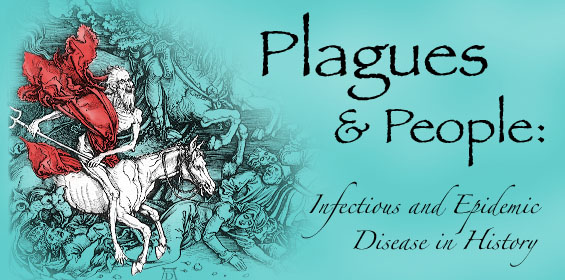

History 135F
Department of History
University of California, Irvine
I hope the information and ideas you find on these pages will both satisfy and further stimulate the curiosity that led you here. Instructor: Dr. Barbara J. Becker
Chapel Hill, April 2010 |
||
Humans, like all living things, are both home and food to countless microbes and parasites. We co-exist peacefully with some, fight others to the death, and routinely share them all -- good germs and bad -- with everyone we meet. Occasionally, the consequences of our intimate relationship with agents of infectious disease are brutal. Epidemics tax available political, economic, and spiritual resources. And, they pose serious challenges to prevailing paradigms of medical theory and practice. How has society, in particular the segment charged with healing the sick, responded to these challenges?
|
||
| Week 1. Crowds | |
| 1. Costs of civilization 2. Epidemic disease before 1300 CE |
Reading: Week
1 Readings Hays, ch. 1 |
| Week 2. Calamities | |
| 3. The Black Death (1347): antecedents 4. The Black Death (1347): aftermath |
Reading: Week
2 Readings Hays, chs. 2-3; Gottfried, chs. 1-5 |
| Week 3. Context | |
| 5. Medical practice: ancient legacy 6. Medical practice: early modern |
Reading: Week
3 Readings Gottfried, chs. 6-7 & epilogue |
| Week 4. Colonies | |
| 7. The New World 8. The Old World |
Reading: Week
4 Readings Hays, ch. 4; Zinsser |
| Week 5. Carnalities | |
| 9. Syphilis 10. Tuskegee |
Reading: Week
5 Readings Hays, ch. 5; Quetel |
| Week 6. Contagion? | |
| 11. Medical practice: 17th century 12. The Great Plague: London, 1665 |
Reading: Week
6 Readings Hays, chs. 6-7; Defoe |
| Week 7. Cure? | |
| 13. Smallpox 14. Yellow Fever |
Reading: Week
7 Readings Hays, chs. 8-9; Rosenberg |
| Week 8. Contact? | |
| 15. Cholera 16. Tuberculosis | Reading: Week
8 Readings Hays, chs. 10-22; Dubos |
| Week 9. Cleanliness? | |
|
17. Polio 18. In-Flu-Enza |
Reading: Week
9 Readings Hays, ch. 12; Rogers |
| Week 10. Contemporary plagues | |
|
19. Hemorrhagic fevers 20. HIV/AIDS |
Reading: Week
10 Readings Guillemin; Crichton |
|
|
|
Michael Crichton, The Andromeda Strain
|